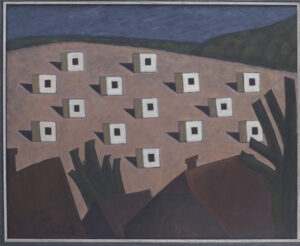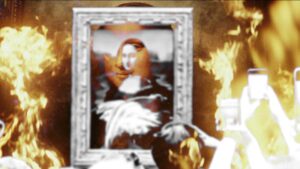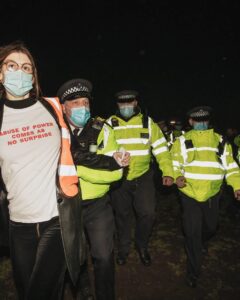While mainstream intellectuals discuss the dawning of a new post-pandemic world live on Zoom and newspapers, for many the sun has risen already and been up in the sky for quite a while. Speaking of a crisis – in singular – makes us forget what philosopher Gabriel Rockhill puts forward with much simplicity from a perspective of radical historicism: “we always start in the middle, so to speak, in a complex nexus of immanent, historically constituted notions and practices.” [1] Rather than reimagining our practices from a theoretical and unattainable scratch point, the pandemic brings us (yet again), the opportunity of turning to existing know-hows of collectively dealing with precarity.
After the strict stay-at-home order enforced by the Argentine government, an immediate rise on femicides followed: in approximately 40 days of seclusion, 36 femicides took place. [2] Women artists collective La Lola Mora, based in the northwest province of Tucumán, responded quickly with the campaign Face Mask, Not Muzzle. It consisted on the online publication on social media of selfies of Las Lolas, wearing self-made face masks with defiant phrases embroidered, stamped, painted digitally, or by hand on them. The collective put up a website on which they socialized the pattern to sew face masks and incited others to produce their own “screaming models” – as La Lola Alejandra Mizrahi describes them. [3] Soon, other femmes from all over the country submitted their own portrait, the images got reposted and, in a conservative and catholic province such as Tucumán, the main local newspaper La Gaceta published an article on the initiative.
While artists all around the globe started to intervene face masks during the pandemic, the singular force of La Lola’s action lies, first, on the repurposing of these protective tools as protest placards for a world of confinement and virtuality. Secondly, it lies on rapidly perceiving and questioning the aestheticization of the face mask-selfie and, therefore, of the verticality of State’s biopolitics and its monolithic understanding of care. Contrary to the reactionary movements that spread in neoliberal democracies demanding an end to stay-at-home orders and asking to sacrifice the lives of those made most vulnerable in the sake of the economy goddess, La Lola Mora embraces State’s protective measures while calling for an expanded, horizontal, and feminist understanding of care that takes into account the ongoing gender crisis.
Performative political intervention has a distinct genealogy in Argentine recent history. During the last military dictatorship (1976-83), Madres de Plaza de Mayo – the collective of mothers of those who were disappeared by the apparatus of State terrorism – strived for visibility through political performance. Their most emblematic action was to march in circles in Buenos Aires’ main square, around one of its monuments, carrying photographs of their missing daughters and sons. Many of these photographs were taken from national identity cards. Thus, while the military government denied knowledge of those who they have secretly abducted, their mothers – as Ana Longoni argues – weaponized the state tools for identification against the very government who had initially issued them. [4] After the dictatorship, they developed an array of visual techniques to involve society in their struggle for the prosecution and incarceration of the military. They organized the March of the White Masks, in which thousands marched with identical white masks covering their faces. As Longoni points out: “This procedure made the demonstrators — each carrying a mask and thus becoming anonymous — once again stand in for the missing persons, each demonstrator lending his or her body and life to the disappeared.”[5] So powerful were the Madres’s actions that renowned critic Diana Taylor almost built an entire theory on performance and politics after conducting research with them and with other associations of relatives. [6] So impactful were these performances that they stayed alive in the collective imaginary, forming a contestatory repertoire of protest actions and becoming what Taylor calls the DNA of performance, which draws from “not only the biology and the performance, but the archive and repertoire. The linkage refutes colonial notions that the archival and biological is more lasting or accurate than embodied performance practice.” [7] Still today, Argentines collectively embody the memory of the disappeared, year after year, by marching on the anniversary of the military coup, carrying their portraits and shouting out their names. With time, these strategies started to be deployed in protests against women trafficking, femicides, and tranvesticides – cases that have come to known of as the disappeared under democracy.
It comes as no surprise then that Las Lolas – as a feminist action collective – were able to rapidly intervene in the social field during the pandemic through innovative visual politics. La Lola Mora is a collective of artists from all disciplines, born as the Tucumán chapter of the larger women artists’ collective Nosotras Proponemos. They soon felt that the former, a Buenos Aires centered group, did not address the scope and urgency of the issues that mobilized them. While Nosotras Proponemos is primarily focused on fighting for equal representation in the visual art world, these Tucumán artists felt more compelled to intervene in social issues such as the debate around the legalization of abortion that took place in Argentina in 2018. They founded La Lola Mora then, named after the acclaimed modernist sculptor from Tucumán who defied male hegemony in the arts of late XIX century Argentina. They designed an apron with their logo – identifying themselves as art laborers and wearing it as a collective identifier – and went out together to march in pro-choice demonstrations, organized rallies, socialized the pattern for their apron as a way of calling others to join their causes, and did things like presenting a list of demands to the Ministry of Culture in Tucumán that expanded well beyond the problem of gender representation in culture. For example, they allied with weavers from indigenous communities in the province’s valleys and included the latter’s concerns in their demands, opposing the longstanding racist divide between fine arts and crafts still visible in cultural public policies. In consequence, they form a collective of artists mobilized not by the singular crisis of an ideal national identity – the way in which the pandemic is officially presented (We are all in this together!) -but by a built up state of precarity that results from the overlapping crises of neoliberal and patriarchal violence: gender and race inequality, femicides, the immense regional imbalance between the city of Buenos Aires and the 23 provinces of the Federal Republic, etc.
When COVID-19 arrived, they had already established a collective know-how for creatively intervening in political struggles. Facing the imminent possibility of a health system collapse, their first action was to start producing face masks and other protective tools that were lacking to donate them to public hospitals. This group effort was not realized without internal controversy. Members of the group felt that it was unfair that – in a declared anti-choice province, filled with doctors who are conscientious objectors and who have even forced raped underage women to give birth – they went out to supply the needs of their ideological rivals. In spite of their internal debates, they moved forward and embraced the controversy through individual statements on social media in which they shared their conundrum. Furthermore, they socialized the pattern to sew face masks with whatever fabric people had in their homes and got criticized for promoting the use of non-specific fabrics. They understood that in the urgency of matters, knowing the deep precarity of many people in Tucumán, it was best if they had, at least, something to protect themselves. Interestingly, many Lolas work in governmental entities such as the National University of Tucumán and other public cultural entities. These were among the first to privately question their actions. However, after the impact of Face Mask, Not Muzzle, they got invited by the School of the Arts of the National University of Tucumán to do a promotional video inviting the academic community and others to partake. This represents a particularly interesting feedback loop between a social movement and the government. It disrupts what philosopher Flavia Dezzutto identifies as a “precarious mediation” in progressive governments – such as the one currently in power in Argentina – which limits “the empowerment and capacity for autonomy” of social movements “inhibiting the dynamics of building people’s power.” [8]
By turning the face mask-selfie into a contestary image for protest against the subsuming of the gender crisis under the health crisis, Las Lolas follow the traces of the Madres de Plaza de Mayo – activating the DNA of performance present in the particular chain of the Argentine feminist movement. In a similar fashion to how Madres weaponized the stated identity card against the military government, Las Lolas – while embracing the need for a stay-at-home order – deploy the face mask against the very government that enforces its use. With embroidered phrases such as ¿Dónde está Daiana? [Where is Daiana?] that demand truth and justice for a recent victim of women trafficking, Las Lolas lend their bodies to the disappeared as it happened with the Madres’ Mask March. Having their noses and mouths covered and refusing to include individual names on their online postings, they maintain a kind of collective anonymity that reinforces the notion that femicides and patriarchal violence are not a problem of some but that they should concern all citizens equally. Las Lolas wear their face masks as the Zapatistas wear their ski-masks: highlighting the resolution and ferociousness of the struggle in their eyes.
After the posting of the first selfies, the relatives of Daiana decided to join the campaign and posted their own face mask-selfies. With this action, La Lola inverted the trajectory of the Madres’ action – producing a kind of questioning that goes from the larger societal framework into the family sphere. This is particularly compelling in considering that Face Mask, not Muzzle was partly a reaction to government’s slogan #Tapatelaboca [#Coveryourmouth]. This necessary protective mandate resounds inevitably, in a heteropatriarchal society, with the implicit commandment to remain silent or avoid confrontation in the face of sexist violence. La Lola them strategically appropriates the government’s slogan to denounce centuries of silencing and contest the heteronormative imaginary that surrounds the stay-at-home order and its rhetorics of valuing home and family. As seen, activating the DNA of performance means both repeating available gestures and strategies but also actualizing them in the face of our current situation of confinement and virtuality. As philosopher Diego Sztulwark suggests, “when a body discovers common purpose along with others, it engenders a knowledge that goes beyond itself” [9] establishing a “ practical knowledge of counter-power.” [10] La Lola, tuned in with the present and deeply affected by the ongoing crises of gendered, racialized, and provincialized bodies in Argentina, produce what we could call a thinking-in-motion, a thought on the march, that is the result of a militant trajectory inscribed in a particular historicity.
Acknowledging the strength of the theoretical proposal of an action collective must not imply an anti-intellectual statement. We might recuperate the words by philosopher León Rozitchner that Sztulwark often cites: “When the people do not fight, philosophy does not think.”[11] La Lola Mora reminds us that is not through abstract discussions on ideals for the future that we will come out of the pandemic transformed but through actively undoing today the hierarchies in our fields of aesthetic and political practices. Appropriating the judeo-christian saying that there is nothing new under the sun, we might understand that instead of discussing a new dawn, it is time to walk the walk –under the burning sunbeam.
Notes
1 Rockhill, Gabriel. Radical History & the Politics of Art. New York: Columbia University Press, 2014, p. 51.
2 See: https://www.filo.news/actualidad/36-femicidios-en-Argentina-desde-que-inicio-la-cuarentena-2020050 1-0033.html
3 Interview with the author, 2020.
4 Longoni, Ana. 2010. Photographs and Silhouettes: Visual Politics in the Human Rights Movement of Argentina. Vol. 25 University of Chicago Press.
5 Ibid, p. 14.
6 See Taylor, Diana. 2002. quot;You are here”: The DNA of Performance. Vol. 46 The MIT Press.
7 Ibid.
8 Interview with Flavia Dezzutto, La Mar en Coche, August 28, 2018, available on marencoche.wordpress.com.
9 Sztulwark, Diego. La Ofensiva Sensible. Buenos Aires. Caja Negra, 2019. p.19
10 Ibid, p. 111.
11 Ibid, p. 19.
Image
Screenshot from the website of the Tucumán collective La Lola Mora, showing their online action Face Mask, Not Muzzle.
About the author
Leandro Martínez Depietri is a curator and researcher based between Buenos Aires and Chicago. His work explores contemporary arts and politics in South America through the lenses of performance studies, critical race theory, and queer theory. He has worked for BIENALSUR, the International Contemporary Art Biennial of South America as a member of the curatorial team in the development of its second edition, which took place between June and October 2019. For a former edition, he co-curated with Florencia Battiti the exhibition A Trail on Earth. Echoes of Institutional Violence from Latin America. Between 2014 and 2017, he worked as an associate curator for PASTO Galería and independently curated exhibitions for Centro Cultural Parque de España, Universidad di Tella, Galería Isla Flotante and others. In 2017, he was awarded a New Artist Society scholarship from the School of the Art Institute of Chicago to pursue a masters in Visual and Critical Studies; for which he developed a thesis on absurdity as a form of political dissent in the face of Cold War violence.
Cite as
Leandro Martínez Depietri. “Thinking in motion,” JVC Magazine, 17 January 2021, https://www.journalofvisualculture.org/thinking-in-motion/





